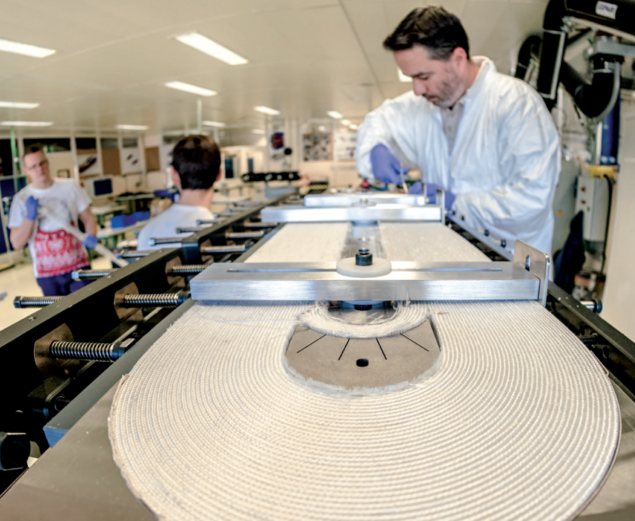The Economics of Big Science: Essays by Leading Scientists and Policymakers, edited by Hans Peter Beck and Panagiotis Charitos, Springer

Recent decades have seen an emphasis on the market and social value of fundamental science. Increasingly, researchers must demonstrate the benefits of their work beyond the generation of pure scientific knowledge, and the cultural benefits of peaceful and open international collaboration.
This timely collection of short essays by leading scientific managers and policymakers, which emerged from a workshop held during Future Circular Collider (FCC) Week 2019, brings the interconnectedness of fundamental science and economics into focus. Its 18 contributions range from procurement to knowledge transfer, and from global-impact assessments to case studies from CERN, SKA, the ESS and ESA, with a foreword by former CERN Director-General Rolf Heuer. As such, it constitutes an important contribution to the literature and a guide for future projects such as a post-LHC collider.
As the number and size of research infrastructures (RIs) has grown over the years, describes CERN’s head of industry, procurement and knowledge transfer, Thierry Lagrange, the will to push the frontier of knowledge has required significant additional public spending linked to the development and upgrade of high-tech instruments, and increased maintenance costs. The socioeconomic returns to society are clear, he says. But these benefits are not generated automatically: they require a thriving ecosystem that transfers knowledge and technologies to society, aided by entities such as CERN’s knowledge transfer group and business incubation centres.
RIs need to be closely integrated into the European landscape, with plans put in place for international governance structures
Multi-billion public investments in RIs are justified given their crucial and multifaceted role in society, asserts EIROforum liaison officer at the European Commission, Margarida Ribeiro. She argues that new RIs need to be closely integrated into the European landscape, with plans put in place for international governance structures, adequate long-term funding, closer engagement with industry, and methodologies for assessing RI impact. All contributors acknowledge the importance of this latter point. While physicists would no doubt prefer to go back to the pre-Cold War days of doing science for science’s sake, argues ESS director John Womersley, without the ability to articulate the socioeconomic justifications of fundamental science as a driver of prosperity, jobs, innovation, startups and as solutions to challenges such as climate change and the environment, it is only going to become more difficult for projects to get funding.
A future collider is a case in point. Johannes Gutleber of CERN and the FCC study describes several recent studies seeking to quantify the socioeconomic value of the LHC and its proposed successor, the FCC, with training and industrial innovation emerging as the most important generators of impact. The rising interest in the type of RI benefits that emerge and how they can be maximised and redistributed to society, he writes, is giving rise to a new field of interdisciplinary research, bringing together economists, social scientists, historians and philosophers of science, and policymakers.
Nowhere is this better illustrated than the ongoing programme led by economists at the University of Milan, described in two chapters by Florio Massimo and Andrea Bastianin. A recent social cost–benefit analysis of the HL-LHC, for example, conservatively estimates that every €1 of costs returns €1.2 to society, while a similar study concerning the FCC estimates the benefit/cost ratio to be even higher, at 1.8. Florio argues that CERN and big science more generally are ideal testing grounds for theoretical and empirical economic models, while demonstrating the positive net impact that large colliders have for society. His 2019 book Investing in Science: Social Cost-Benefit Analysis of Research Infrastructures (MIT Press) explores this point in depth (CERN Courier September 2018 p51), and is another must-read in this growing interdisciplinary area. Completing the series of essays on impact evaluation, Philip Amison of the UK’s Science and Technology Facilities Council reviews the findings of a report published last year capturing the benefits of CERN membership.
The final part of the volume focuses on the question “Who benefits from such large public investments in science?”, and addresses the contribution of big science to social justice and inequalities. Carsten Welsch of the University of Liverpool/Cockcroft Institute argues that fundamental science should not be considered as a distant activity, illustrating the point convincingly via the approximately 50,000 particle accelerators currently used in industry, medical treatments and research worldwide.
The grand ideas and open questions in particle physics and cosmology already inspire many young people to enter STEM subjects, while technological spin-offs such as medical treatments, big-data handling, and radio-frequency technology are also often communicated. Less well known are the significant but harder-to-quantify economic benefits of big science. This volume is therefore essential reading, not just for government ministers and policymakers, but for physicists and others working in curiosity-driven research who need to convey the immense benefits of their work beyond pure knowledge.








